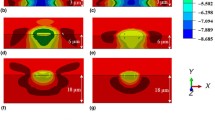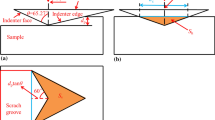Abstract
Most existing models describing the scratch properties of materials take into account forces acting at the interface between the material and a grooving tip, but do not consider the stress and strain properties of the material far beneath or ahead of the tip. In the case of polymer scratches, there are no models at all which take into account the viscoelastic viscoplastic behaviour of the material. In standard indentation tests with a non moving tip, the elastic plastic boundary and the limits of the region subjected to hydrostatic pressure beneath the tip are known. These models were used to analyse the geometry of the grooves left on the surface of a viscoelastic viscoplastic body by a moving cone-shaped diamond tip having a radius of about 40 μm. A new apparatus was built to control the velocity of the tip over the range 1 to 104 μm/s, at several different temperatures from −10°C to 100°C. The material was a commercial grade of cast poly(methylmethacrylate) (PMMA). The normal and tangential loads and groove size were used to evaluate the dynamic hardness, which behaved like a stress and temperature activated process. Values of the activation energy and volume of the dynamic hardness and of the interfacial shear stress were in good agreement with those usually attributed to the mechanical properties of PMMA.
Similar content being viewed by others
References
H. Czichos, in “Composite Materials Series, Vol. 1,” edited by K. Friedrich (Elsevier, 1986) p. 1.
E. Rabinowicz, “Friction and Wear of Materials,” (J. Wile & Sons, 1965).
F. P. Bowden and D. Tabor, “Friction and Lubrication of Solids,” (Oxford University Press, London, 1951).
B. Lamy, in “Microscopic Aspect of Adhesion and Lubrification,” edited by J. M. Georges (Elsevier, 1982) p. 599.
A. J. Sedricks and T. O. Mulhearn,Wear 6 (1963) 457.
I. V. Kragelsky, “Friction andWear,” (Butterworth, London 1965).
P. Berthoud and T. Baumberger, Europhys. Lett. 6 (1998) 617.
K. L. Johnson, K. Kendall and A. D. Roberts, Proc. R. Soc. Lond. A324 (1971) 301.
B. J. Briscoe, P. D. Evans, S. K. Biswas and S. K. Sinha, Tribology International 2 (1996) 93.
K. L. Johnson, “Contact Mechanics,” (Cambridge University Press, 1984).
Idem., J. Mech. Phys. Solids 18 (1970) 115.
B. J. Briscoe, in “Composite Materials Series, Vol. 1,” edited by K. Friedrich (Elsevier, 1986) p. 25.
B. J. Briscoe and P. S. Thomas, Tribology Transactions 38 (1995) 382.
J. L. Loubet, J. M. Georges and G. Meille, in “Microindentation Techniques in Materials Science and Engineering,” ASTM, STP 889, edited by P. J. Blau and B. R. Lawn (ASTM Philadelphia, 1986) p. 72.
J. M. Lefebvre and B. Escaig, Polymer 3 (1993) p. 518.
B. N. Lucas, W. C. Oliver, G. M. Pharr and J.-L. Loubet, in “Symposium Proceedings 436, Thin Films: Stresses and Mechanical Properties VI,” edited by W.-W. Gerberich, H. Gao, J.-E. Sundgren and S. P. Baker (Materials Research Society, 1997), p. 233.
C. Bouton-Rochelle, PhD, INPL, France, 1991.
L. Odoni, PhD, Ecole Centrale de Lyon, France, 1999.
N. A. Fleck, W. J. Stronge and J. H. Liu, Proc. R. Soc. Lond. A429 (1990) p. 459.
Author information
Authors and Affiliations
Rights and permissions
About this article
Cite this article
Gauthier, C., Schirrer, R. Time and temperature dependence of the scratch properties of poly(methylmethacrylate) surfaces. Journal of Materials Science 35, 2121–2130 (2000). https://doi.org/10.1023/A:1004798019914
Issue Date:
DOI: https://doi.org/10.1023/A:1004798019914




